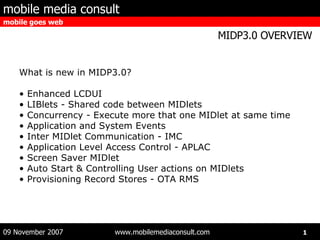MIDP3.0, overview of a right Android rival
- 1. What is new in MIDP3.0? Enhanced LCDUI LIBlets - Shared code between MIDlets Concurrency - Execute more that one MIDlet at same time Application and System Events Inter MIDlet Communication - IMC Application Level Access Control - APLAC Screen Saver MIDlet Auto Start & Controlling User actions on MIDlets Provisioning Record Stores - OTA RMS
- 2. MIDP3.0 JSR 271 Expert group formed in March 2005 Expert Group Lead by Mike Milikich from Motorola Over 100 members including: Device Manufacturers Network Operators Application & Content Developers VM Vendors
- 3. MIDP3.0 Release date Final Approved Version Expected Q2-2008
- 4. MIDP3.0 LCDUI ®C High Level Custom layout support: Application controls Layout of items in a Form Flow and Table Layout Commands Improved placement control Sub ®C Commands Icons Tabbed Panes ®C each pane contains a Screen Idle Item support Image Item to support GIF / animated GIF
- 5. MIDP3.0 LCDUI ®C Low Level Support for multiple Displays and orientations Alpha blending Image enhancements Animated Images Transparent mutable Images Scaling and rotation Application-provided Fonts Splash screens
- 6. LIBlets Shareable components that one or many midlets can use Expose a set of API°Øs and resources that a MIDlet can use Inert code and resource fragments that only execute within a MIDlet context. Save static footprint size by preventing LIBlet code packaged in each MIDlet. Potentially reduce download times for applications
- 7. LIBlets LIBlet code does not execute by itself LIBlet is executed in the MIDlet°Øs execution enviroment A binding: act of loading a MIDlet with all associated LIBlets into a single execution enviroment. Jars are all in the classpath
- 8. Concurrency Multiple MIDlets: AMS provides a means to launch multiple applications MIDlets in the background, not visible to the user Auto Start MIDlets Screen Saves MIDlets
- 9. Application and System Events MIDlets can generate applicatino events MIDlets can listen to System events Battery power on/off idle event Push registration on events: Application launch on event launch application on flip/close
- 10. Inter MIDlet Communication (IMC) Communication between multiple running MIDlets Low-level bi-directional stream connection within the device GCF based ®C Connector.open(°∞imc://...°±); An IMC Server is created with a name, and the client tries to connect to this named service. MIDlet A IMCConnection MIDlet B IMCServerConnection
- 11. APLAC Application Level Access Control (APLAC) MIDlets interact via Events, IMC, RMS Restrinct interactions based on Domain Signer Vendor E.g. Share a record store only with MIDlets that are developed by a specific Vendor











